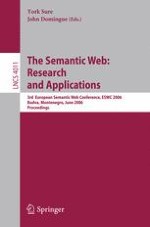2006 | Buch
The Semantic Web: Research and Applications
3rd European Semantic Web Conference, ESWC 2006 Budva, Montenegro, June 11-14, 2006 Proceedings
herausgegeben von: York Sure, John Domingue
Verlag: Springer Berlin Heidelberg
Buchreihe : Lecture Notes in Computer Science
